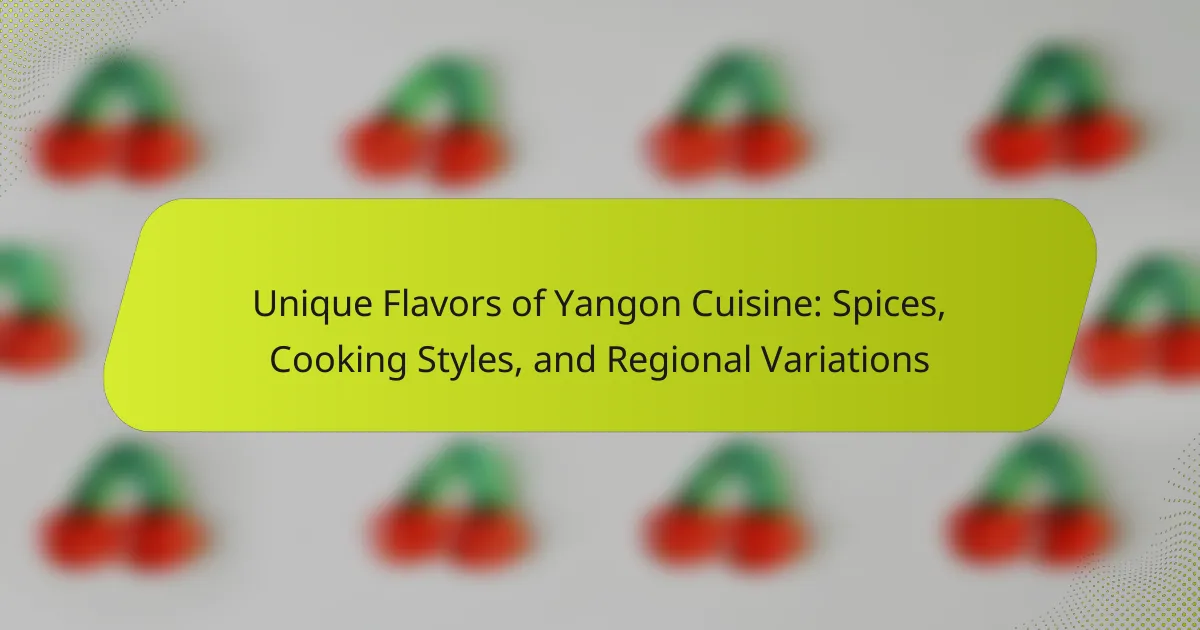Yangon cuisine is characterized by a unique blend of flavors, influenced by a variety of spices, herbs, and cooking techniques. Key ingredients include fish sauce, shrimp paste, lemongrass, turmeric, and ginger, which create a distinct taste profile that balances sweet, sour, and spicy elements. Popular dishes such as Mohinga, a fish broth with rice noodles, highlight the region’s culinary diversity and its reliance on fresh vegetables and seafood, due to Yangon’s coastal geography. The article explores the essential ingredients, traditional cooking methods, and the vibrant street food culture that define Yangon’s culinary identity, offering insights into the preparation and etiquette associated with enjoying this rich cuisine.

What are the Unique Flavors of Yangon Cuisine?
Yangon cuisine features unique flavors characterized by a blend of spices, herbs, and cooking techniques. Key flavors include the use of fish sauce, shrimp paste, and fermented ingredients. Ingredients like lemongrass, turmeric, and ginger contribute to the distinct taste. Dishes often combine sweet, sour, and spicy elements. For example, Mohinga, a popular breakfast dish, showcases a rich fish broth with rice noodles and spices. The use of fresh vegetables and herbs enhances the overall flavor profile. Regional variations introduce local ingredients, adding diversity to the cuisine. The culinary traditions reflect Myanmar’s cultural influences and history.
How do spices influence the taste of Yangon dishes?
Spices significantly enhance the taste of Yangon dishes by adding depth and complexity. They introduce various flavor profiles such as heat, sweetness, and earthiness. Common spices used include turmeric, chili, garlic, and ginger. Turmeric provides a warm, slightly bitter flavor that is fundamental in many dishes. Chili adds heat and can vary in intensity, influencing the overall spiciness of the meal. Garlic contributes a robust aroma and savory taste, while ginger adds a fresh, zesty note. The combination of these spices creates a harmonious balance, making Yangon cuisine vibrant and distinctive. Additionally, the use of spices reflects the region’s cultural influences and culinary traditions, which further enriches the dining experience.
What are the most commonly used spices in Yangon cuisine?
The most commonly used spices in Yangon cuisine include turmeric, chili powder, garlic, and ginger. Turmeric adds a vibrant yellow color and earthy flavor to dishes. Chili powder provides heat and depth to various recipes. Garlic is essential for its aromatic qualities and enhances overall taste. Ginger contributes a fresh, zesty note that balances flavors. These spices reflect the rich culinary heritage of Myanmar, emphasizing bold and complex flavors.
How do these spices vary in flavor profiles?
Spices vary in flavor profiles based on their chemical composition and origin. For example, turmeric has a warm, earthy flavor with a hint of bitterness. In contrast, chili peppers provide a sharp, spicy heat that can range from mild to extremely hot. Coriander offers a citrusy, slightly sweet taste, while cumin has a nutty, warm flavor. These unique profiles influence how spices are used in dishes. Historical usage in Yangon cuisine showcases these variations effectively. Each spice contributes distinct notes, enhancing the overall taste experience.
What cooking styles define Yangon cuisine?
Yangon cuisine is defined by a blend of various cooking styles. These styles include steaming, frying, and grilling. Steaming is commonly used for dishes like mohinga, a traditional fish noodle soup. Frying is prevalent in the preparation of snacks and side dishes, such as samosas and fritters. Grilling is often employed for meats and seafood, enhancing their flavors. The use of fresh herbs and spices is integral to these cooking methods. Ingredients like lemongrass, turmeric, and chili are frequently incorporated. This combination of techniques and flavors reflects the cultural diversity of Yangon. The cuisine showcases influences from neighboring regions, including India and China.
How does the cooking method impact the final dish?
The cooking method significantly impacts the final dish by altering flavor, texture, and nutritional value. Different techniques such as boiling, frying, or steaming create unique outcomes. For instance, frying enhances crispiness while boiling retains moisture. Cooking methods also influence the absorption of spices, affecting overall taste. Steaming preserves nutrients better than frying, impacting health benefits. Each method can change the dish’s aroma and visual appeal as well. Thus, the choice of cooking method is crucial in defining the dish’s final characteristics.
What traditional techniques are used in Yangon kitchens?
Traditional techniques used in Yangon kitchens include steaming, frying, and fermenting. Steaming is commonly employed for dishes like mohinga, a traditional fish soup. Frying is prevalent in preparing snacks such as samosas and fritters. Fermenting is essential for producing ingredients like ngapi, a fermented fish paste. These techniques reflect the region’s culinary heritage. They enhance flavors and preserve food. Many of these methods have been passed down through generations. Their use contributes to the unique taste of Yangon cuisine.
What are the regional variations within Yangon cuisine?
Yangon cuisine features regional variations that reflect diverse cultural influences. These variations include distinct flavors, ingredients, and cooking methods. For instance, the southern regions emphasize seafood, utilizing fresh fish and shrimp in dishes. The central areas focus on rice-based meals, often accompanied by rich curries. Northern influences introduce unique spices and herbs, enhancing the overall flavor profile. Additionally, ethnic communities contribute their culinary traditions, such as Indian and Chinese influences. Yangon’s street food scene showcases these variations, offering a mix of traditional and modern dishes. Overall, the regional diversity in Yangon cuisine creates a rich tapestry of flavors and experiences.
How do geographical factors influence local flavors?
Geographical factors significantly influence local flavors by determining the availability of ingredients. Regions with rich soil and favorable climates produce diverse crops. For example, Yangon’s tropical climate supports the growth of spices like turmeric and lemongrass. Proximity to water sources allows for fresh seafood, impacting flavor profiles. Additionally, altitude affects agricultural practices, influencing what is grown. Historical trade routes also introduce foreign spices, blending flavors. This combination shapes unique culinary identities in local cuisines. Specific studies indicate that local environments directly correlate with ingredient diversity and culinary practices.
What are notable dishes from different regions of Yangon?
Notable dishes from different regions of Yangon include Mohinga, Lahpet, and Shan Noodle. Mohinga is a traditional fish soup served with rice noodles. It is considered the national dish of Myanmar. Lahpet is a unique tea leaf salad that combines fermented tea leaves with various toppings. Shan Noodle is a popular dish featuring flat rice noodles, often served with chicken or pork. Each dish reflects the diverse culinary influences found in Yangon. These dishes showcase local ingredients and cooking techniques unique to the region.
How do cultural influences shape Yangon cuisine?
Cultural influences shape Yangon cuisine through the integration of diverse culinary traditions. The city has a rich history of trade, which introduced various ingredients and cooking techniques. Influences from neighboring countries like India, China, and Thailand are evident in local dishes. For example, the use of curry reflects Indian culinary practices. Chinese cooking methods contribute to the popularity of noodle dishes in Yangon. Additionally, traditional Burmese flavors are enhanced by local spices and herbs. The fusion of these cultural elements creates a unique gastronomic experience. Historical migration patterns have also played a role in shaping the local food landscape. Overall, Yangon cuisine is a testament to the city’s multicultural heritage.
What historical events have impacted the flavors of Yangon dishes?
Colonial rule and trade routes significantly impacted the flavors of Yangon dishes. The British colonial period introduced new ingredients like potatoes and tomatoes. Trade with India and China brought spices such as turmeric and chili. The influx of diverse cultures led to fusion dishes, blending local and foreign flavors. Historical migrations also influenced culinary practices. The arrival of Indian and Chinese immigrants enriched the local cuisine. Additionally, the Japanese occupation during World War II introduced new cooking techniques. These events collectively shaped the unique flavor profile of Yangon cuisine.
How do neighboring countries influence Yangon cooking styles?
Neighboring countries significantly influence Yangon cooking styles through the incorporation of diverse ingredients and techniques. Thai cuisine introduces flavors like lemongrass and coconut milk, enhancing local dishes. Indian cooking contributes spices such as cumin and coriander, which are prevalent in Yangon recipes. Chinese culinary practices also play a role, particularly in the use of stir-frying and noodle dishes. The fusion of these influences creates a unique blend in Yangon’s food culture. Historical trade routes facilitated this exchange, allowing for a variety of cooking methods and ingredients to merge. The result is a vibrant culinary landscape that reflects the region’s multicultural heritage.

What role do ingredients play in Yangon cuisine?
Ingredients are fundamental to Yangon cuisine, shaping its unique flavors and dishes. Fresh herbs and spices are essential, providing distinct tastes and aromas. Common ingredients include garlic, ginger, and lemongrass, which enhance the depth of flavors. Rice is a staple, serving as the base for many meals. Fish and seafood are prevalent due to Yangon’s coastal location, contributing to the local diet. Additionally, legumes and vegetables add nutritional value and variety. The use of fermented ingredients, like fish sauce, adds umami and complexity. Overall, ingredients are vital in defining the culinary identity of Yangon.
What are the staple ingredients in Yangon dishes?
The staple ingredients in Yangon dishes include rice, fish, and vegetables. Rice serves as the primary carbohydrate source in most meals. Fish is often used in various forms, such as fresh, dried, or fermented. Vegetables like onions, garlic, and leafy greens are commonly included for flavor and nutrition. Additionally, legumes, particularly chickpeas and lentils, are frequently used in dishes. These ingredients reflect the local agriculture and culinary traditions of Myanmar. The combination of these staples contributes to the unique flavors characteristic of Yangon cuisine.
How do local markets source fresh ingredients?
Local markets source fresh ingredients through direct relationships with local farmers and producers. Farmers often bring their harvests to the market daily. This ensures that the ingredients are fresh and seasonal. Local markets prioritize sourcing from nearby farms to reduce transportation time. This practice enhances the quality and flavor of the produce. Additionally, many markets have established networks with local suppliers. These networks facilitate a steady supply of diverse ingredients. For example, markets in Yangon often feature vegetables, fruits, and herbs unique to the region. This sourcing method supports local agriculture and the economy.
What unique ingredients are specific to Yangon?
Unique ingredients specific to Yangon include tea leaves, fermented fish sauce, and lentils. Tea leaves are commonly used in salads, known as lahpet. Fermented fish sauce, called ngapi, adds depth to various dishes. Lentils are often used in soups and curries, reflecting the region’s culinary diversity. These ingredients are integral to the local cuisine and showcase the flavors unique to Yangon.
How do seasonal changes affect ingredient availability?
Seasonal changes significantly affect ingredient availability in Yangon cuisine. Certain ingredients are only harvested during specific seasons. For example, tropical fruits like mangoes and lychees are available in the summer months. Conversely, root vegetables such as sweet potatoes are more abundant in the rainy season.
The monsoon season brings a surge in fresh herbs and greens, enhancing local dishes. Additionally, seafood availability fluctuates with fishing seasons and weather patterns. These seasonal variations influence local markets and culinary practices. Chefs adapt recipes based on what is fresh and in season, ensuring optimal flavor and quality.
What dishes are popular during specific seasons?
During specific seasons, traditional dishes in Yangon cuisine vary significantly. In the hot season, salads like “Laphet Thoke” (tea leaf salad) are popular due to their refreshing nature. The rainy season often sees the consumption of hearty soups and stews, such as “Mohinga,” a fish soup that provides warmth and comfort. In the cool season, dishes like “Ohn No Khao Swe” (coconut chicken noodle soup) are favored for their rich flavors and satisfying qualities. Seasonal ingredients also influence these choices, with fresh vegetables and herbs being more prevalent in the hot season. Each dish reflects the local climate and available resources, enhancing the dining experience throughout the year.
How do festivals influence ingredient choices?
Festivals influence ingredient choices by promoting traditional and culturally significant foods. During festivals, communities often emphasize local ingredients that reflect their heritage. This practice helps preserve culinary traditions and fosters a sense of identity. For instance, during the Thingyan Water Festival in Myanmar, dishes like mohinga and various rice cakes are prominently featured. These ingredients are chosen not only for their taste but also for their cultural symbolism. Additionally, festivals encourage the use of seasonal produce, aligning with local agricultural cycles. This connection to the land enhances the freshness and flavor of festival dishes. As a result, ingredient choices during festivals are deeply rooted in cultural significance and local availability.

What are the best practices for enjoying Yangon cuisine?
To enjoy Yangon cuisine, one should explore local street food markets. These markets offer authentic dishes that reflect the city’s culinary heritage. Sampling a variety of foods is essential for experiencing diverse flavors. Dishes like Mohinga, a fish soup, and Tea Leaf Salad are must-tries. Pairing meals with traditional Burmese tea enhances the experience. Engaging with local vendors can provide insights into preparation methods. Observing dining etiquette is important, such as using utensils correctly. Finally, participating in food tours can deepen understanding of Yangon’s culinary scene.
How can one experience authentic Yangon flavors?
To experience authentic Yangon flavors, one should explore local street food and traditional restaurants. Popular dishes include Mohinga, a fish soup with rice noodles, often considered a national dish. Sampling tea leaf salad, known as Lahpet, offers a unique taste of local ingredients. Visiting markets like Bogyoke Aung San Market allows for tasting various snacks and sweets. Engaging with local chefs through cooking classes can provide insights into traditional cooking techniques. Participating in food tours can guide individuals to hidden culinary gems. Authentic flavors often rely on fresh herbs and spices, which are abundant in local cuisine. Each dish reflects the diverse cultural influences present in Yangon.
What are the must-try dishes for newcomers?
Mohinga is a must-try dish for newcomers in Yangon cuisine. It is a traditional fish soup served with rice noodles. Mohinga is often considered the national dish of Myanmar. It features a rich broth flavored with lemongrass, ginger, and garlic. Another essential dish is Shan Noodles. This dish consists of flat rice noodles topped with chicken or pork and a tangy sauce. It originates from the Shan state and showcases local flavors. Tea Leaf Salad is also a highlight. This salad includes fermented tea leaves, nuts, and various vegetables. It is a unique blend of flavors and textures. Finally, newcomers should try Curry with Rice. This dish varies widely across regions. It typically includes a mix of meats and vegetables, served with fragrant rice. Each of these dishes offers a glimpse into the diverse culinary landscape of Yangon.
How can one recreate Yangon flavors at home?
To recreate Yangon flavors at home, focus on using authentic ingredients and traditional cooking methods. Start with essential spices like turmeric, coriander, and chili powder. Incorporate ingredients such as fish sauce, shrimp paste, and coconut milk for depth of flavor. Utilize techniques like steaming and stir-frying, common in Yangon cuisine. Prepare dishes like Mohinga, a rice noodle soup, using fish broth and lemongrass. Explore recipes for tea leaf salad, which combines fermented tea leaves with nuts and sesame. Access to local markets or online stores can help source these ingredients. Following traditional recipes ensures an authentic taste experience.
What tips can enhance the enjoyment of Yangon cuisine?
To enhance the enjoyment of Yangon cuisine, try tasting dishes with local ingredients. Freshness is key in Burmese cooking. Explore street food options for authentic flavors. Street vendors often use traditional recipes passed down through generations. Pair dishes with traditional beverages like tea or beer for a complete experience. Engaging with locals can provide insights into hidden culinary gems. Participating in cooking classes can deepen your appreciation of the cuisine. Lastly, be open to trying new flavors and textures, as Yangon cuisine is diverse and rich.
How should dishes be paired with beverages?
Dishes should be paired with beverages based on complementary flavors and textures. For example, spicy dishes often pair well with sweet beverages to balance heat. Light dishes, such as salads, are best matched with crisp, refreshing drinks. Rich and hearty meals benefit from robust beverages that can stand up to their intensity. Additionally, regional ingredients in dishes can guide beverage choices, such as pairing local beers with traditional meals. Studies show that proper pairing enhances the overall dining experience by elevating flavors and creating harmony.
What dining etiquette is important in Yangon culture?
In Yangon culture, it is important to use the right hand for eating. This practice stems from cultural beliefs about cleanliness. Guests are often expected to wait for the host to begin the meal. It is polite to express gratitude before and after the meal. Sharing food from communal dishes is common. Avoiding pointing with the feet is essential, as feet are considered impolite. Eating slowly and savoring the food is appreciated. Conversations during meals should be light and pleasant. These practices reflect respect for the food and the company.
Yangon cuisine is characterized by its unique flavors, blending spices, herbs, and diverse cooking techniques. Key ingredients such as fish sauce, shrimp paste, and fresh vegetables contribute to the distinctive taste profile, while popular dishes like Mohinga and Lahpet showcase the regional variations influenced by cultural heritage. The article explores the impact of spices on flavor, the significance of cooking methods, and how geographical factors shape local ingredients. Additionally, it highlights traditional techniques, seasonal changes, and the importance of dining etiquette, providing a comprehensive overview of the vibrant culinary landscape of Yangon.
